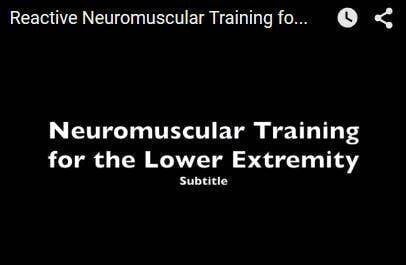
Reactive Neuromuscular Training
Stability as a term has entered the consciousness of the non-medical/rehab realm. The fitness industry often talks about stability but tends to refer to strength and stamina and less about motor control. From a “rehab” perspective, how does one improve your “dynamic stability”. One approach is Reactive Neuromuscular Training.
Reactive Neuromuscular Training (RNT)

From the terminology, you can sort of guess that is involves a form of training of the muscles and the nervous system that controls those muscles. But what’s “Reactive”? Well, that refers to your body’s ability to react.
Dynamic stability is inherently not a conscious process. To hold a body part such as leg, ankle or shoulder steady at a fix position or within a path of movement. not sway in and out of the ideal path, lots of small muscles have to play their part by firing at a precise moment and for short bursts to hold it steady. Very much like what you see in a movie where a small vessel is outer space is trying to navigate to the dock by firing small bursts of gas different direction to hold it steady. The same thing; just much faster with a much shorter burst.
So really what you are trying to do is to train your body to do it reactively, i.e. by reacting to the situation and by controlled by your conscious mind.
The RNT program is the umbrella heading for a variety of rehabilitation techniques designed to restore dynamic stability and fine motor control at an injured joint. The RNT techniques are intended to augment traditional rehabilitation in a complementary fashion via proprioceptive and balance training in order to promote a more functional return to activity.
A Simple Dynamic Stability Exercise for the Leg
Below is a simple but excellent video by Mike Reinold – “A Simple Dynamic Stability Exercise for the Leg”. RNT exercises basically progressing from simple balance on a stable surface (i.e. the floor) to unstable surfaces (thick yoga mats to swiss balls to balance boards), to incorporating functional movements. Here Mike Reinold, a leader in the field of sports medicine, rehabilitation, fitness, and sports performance, uses the exercise band to emphasize training the body’s ability to stabilize in the frontal and transverse planes while performing a sagittal plane exercise.
Related Articles
- Nerves: What Are They and Do We Really Need Them? When we hear the word nerve - some may think about the shocked or disapproving expression describing the audacity…
- HIIT Workouts: Check Your Form (Upper & Lower Body) High-Intensity Interval Training (HIIT) is an increasingly popular and effective way to get lean. HIIT Programmes strip away the…
- Confused over core? What can you do about a better core. If you suffer from back pain, you have likely been told that exercises are good for you; specifically those that…
- Bid Goodbye to Cycling Injuries Cycling is a wonderful sport - it helps you lose weight and keeps you fit. But did you know that…
- Neuro-Muscular Control Neuro-muscular control plays a big role in the management and prevention of chronic back and neck pains. It complements…
